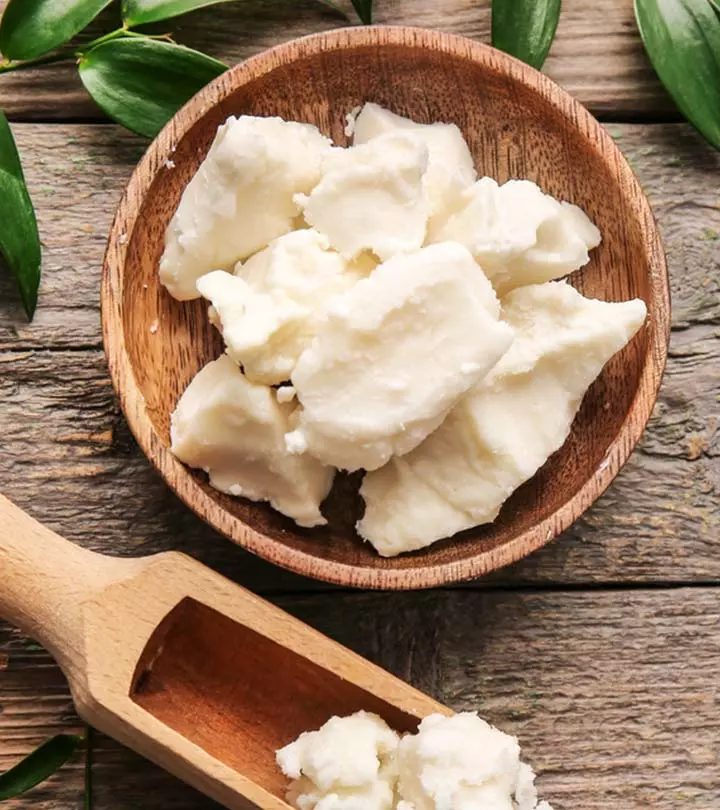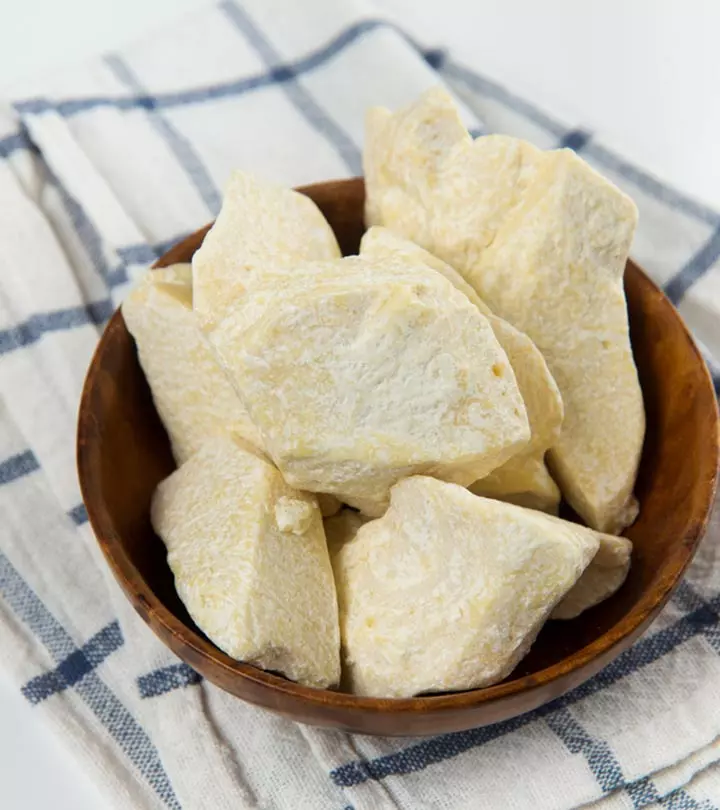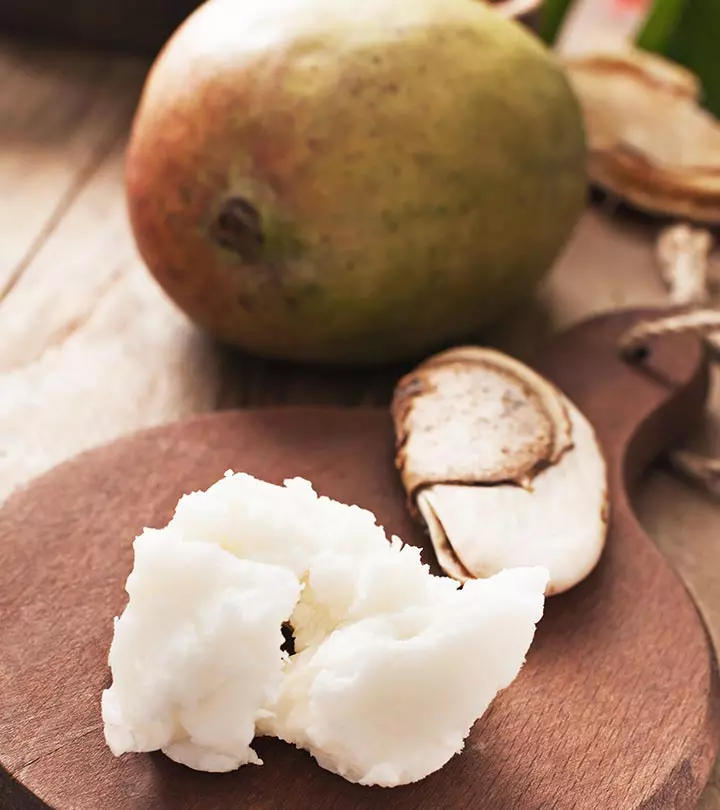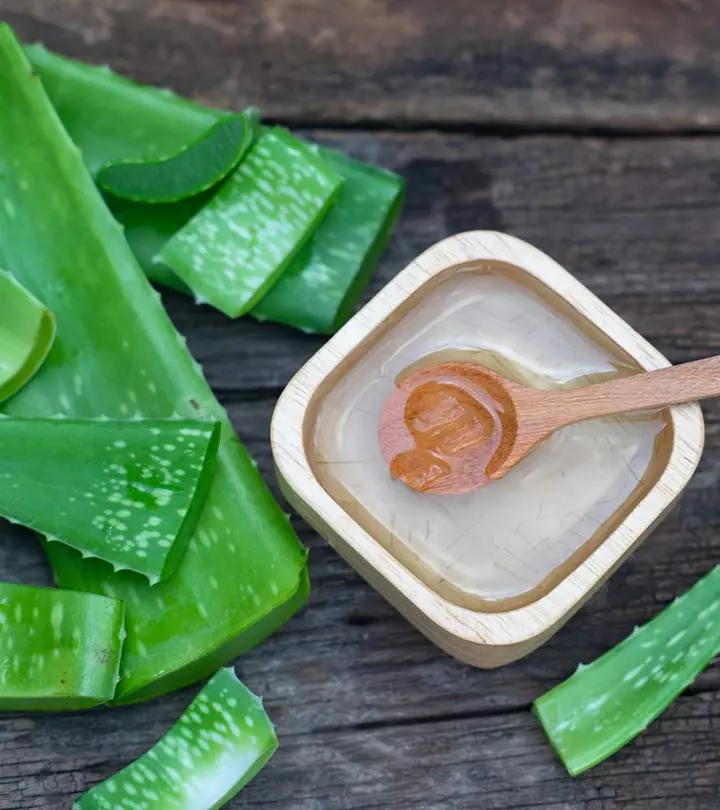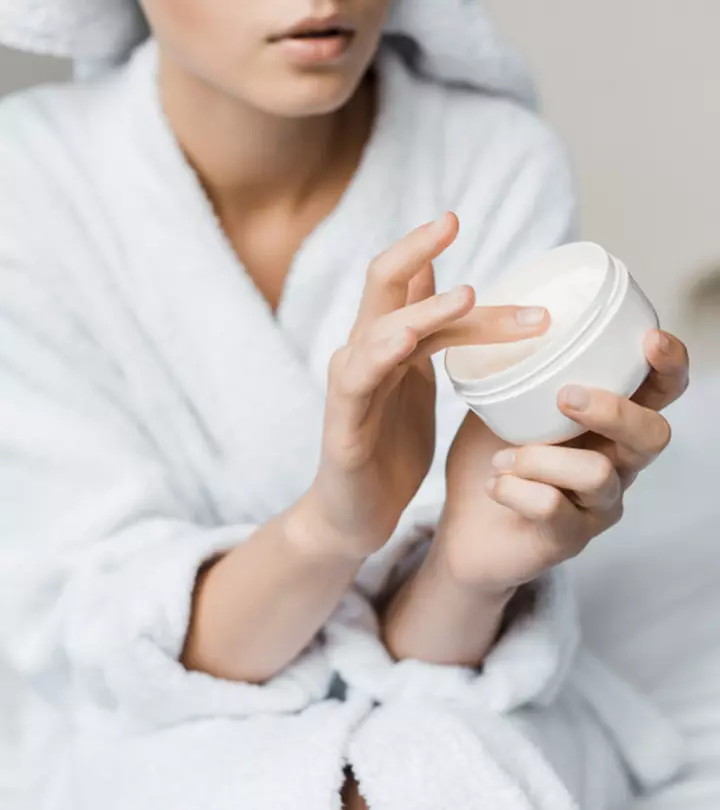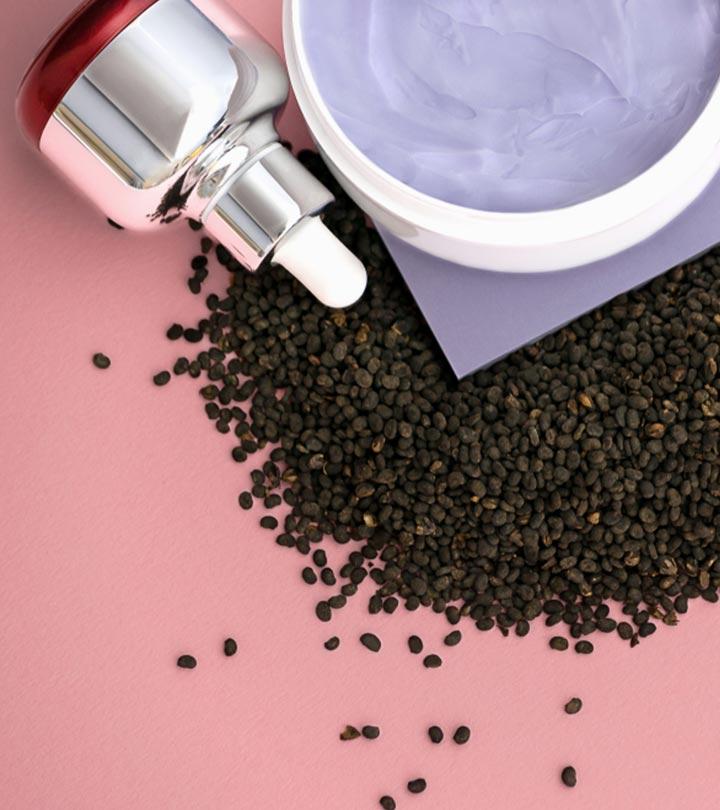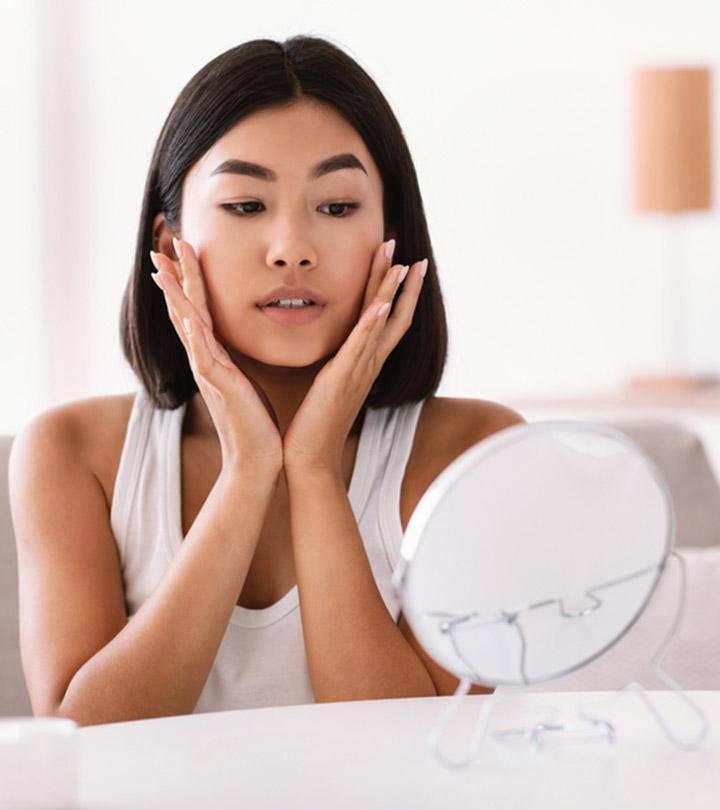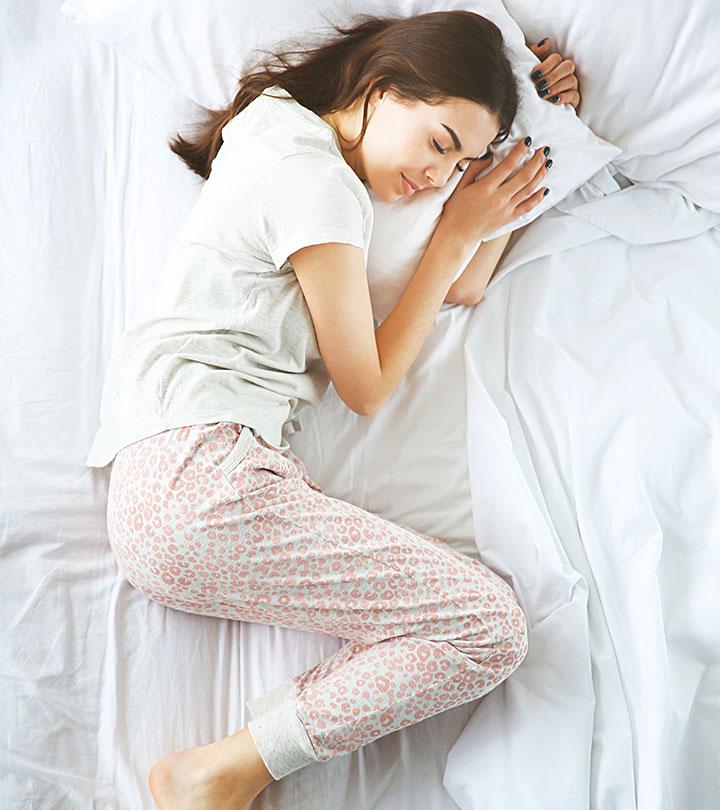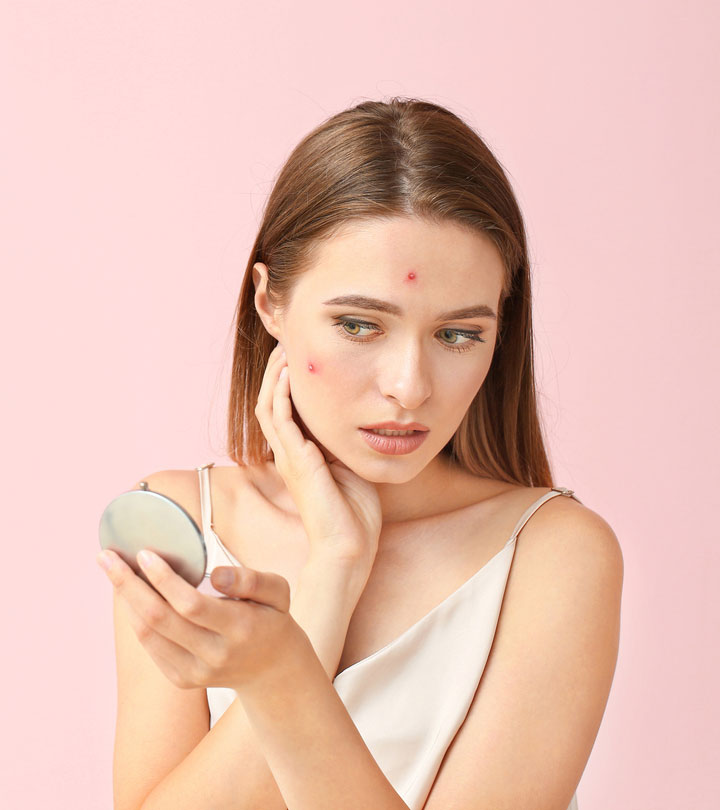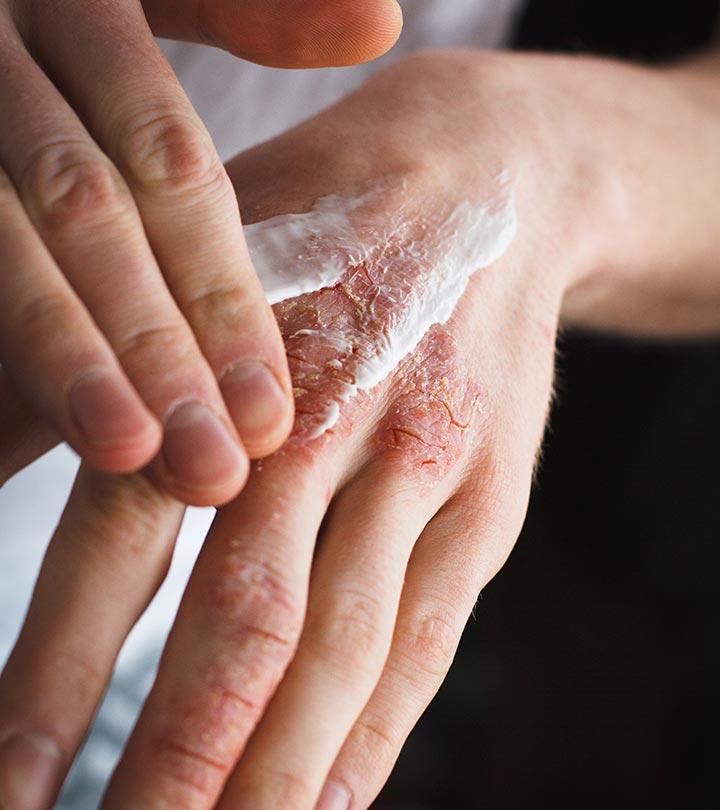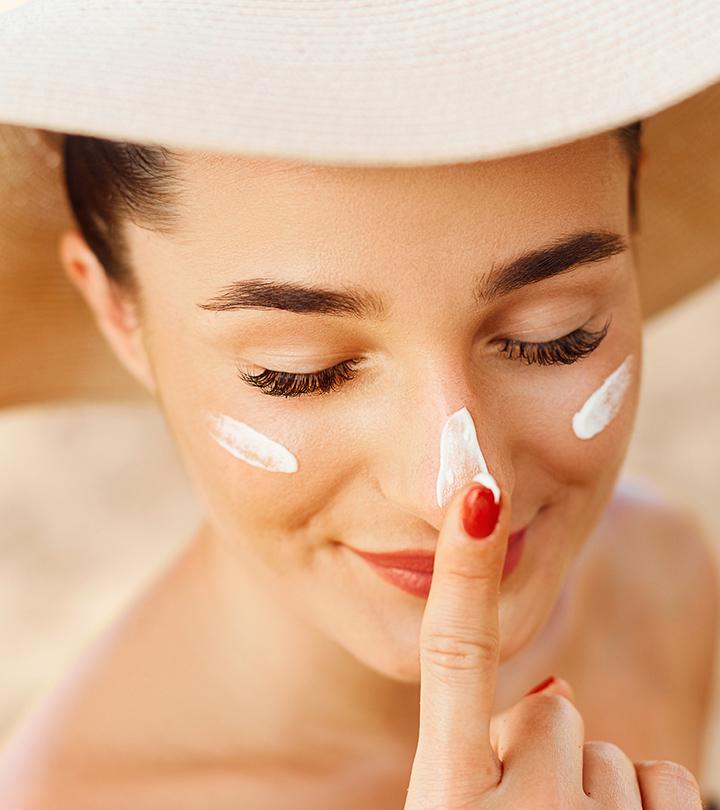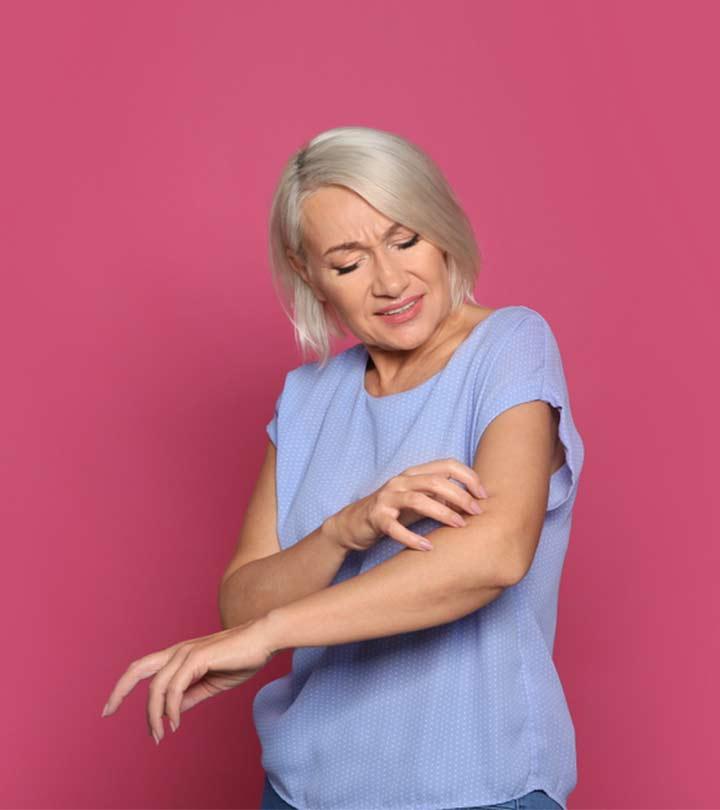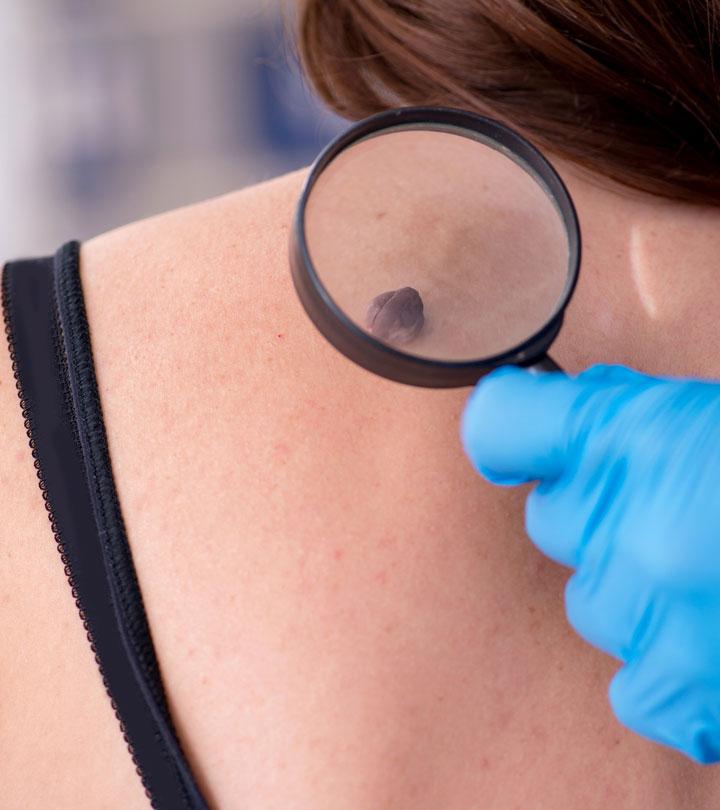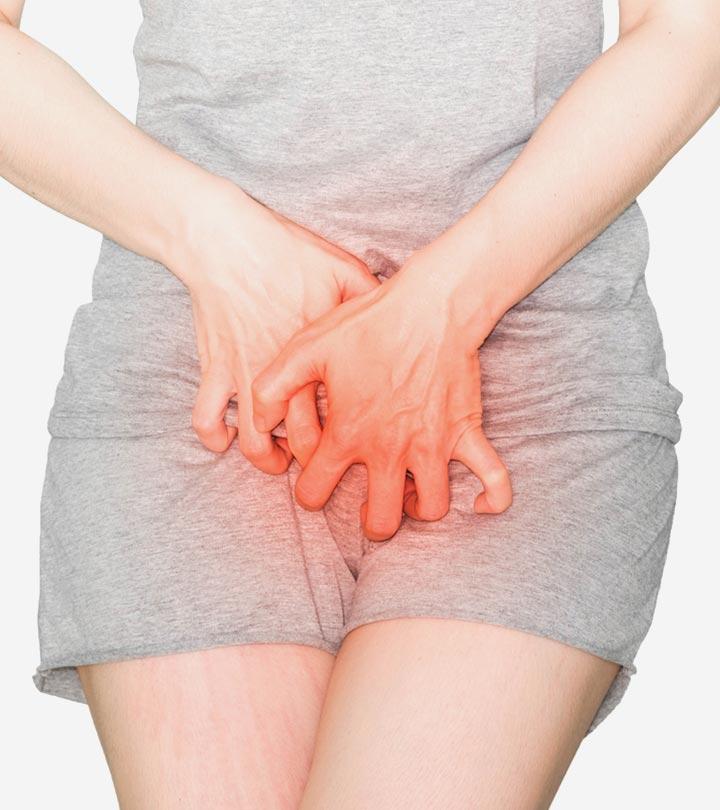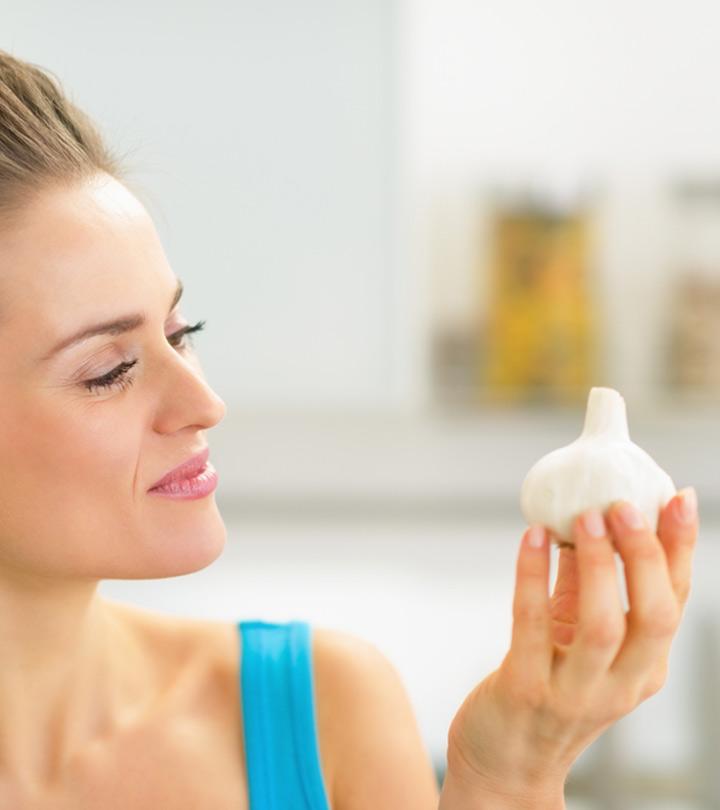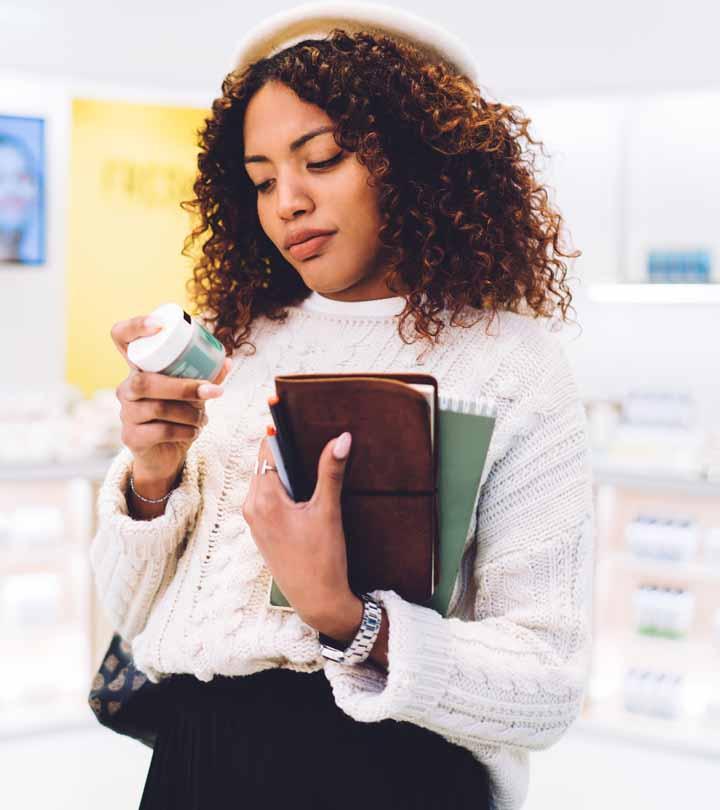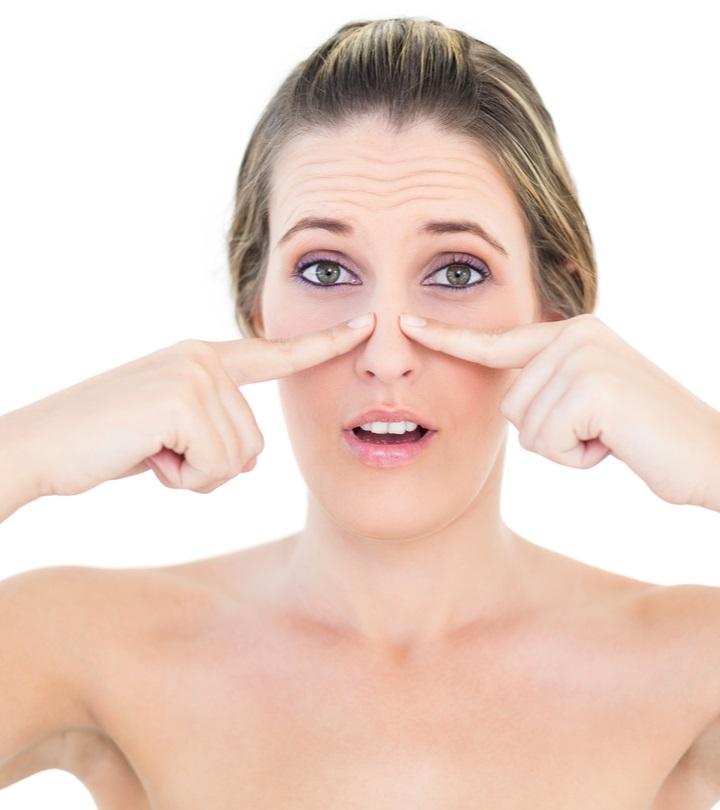Shea Butter For Skin: Benefits, How To Use, And Side Effects
This natural moisturizer should have an irreplaceable spot in your skincare arsenal!

Image: Shutterstock
Pamper your skin with the best moisturizer nature has to offer – shea butter! Shea butter is a common ingredient in many skin care products like lotions, moisturizers, and creams due to its moisturizing properties. It is also said to soothe eczema, reduce the signs of aging like wrinkles and fine lines, and make your skin glow.
This article delves into the benefits of shea butter for the skin, how to use it to make skin care products at home, and its side effects. Keep reading!
In This Article
Benefits Of Shea Butter For The Skin
Shea butter is a popular ingredient in skin care products because extensive scientific evidence proves its benefits for the skin. Listed below are some of its benefits:
Fights Skin Inflammation
Shea butter fights skin inflammation, redness, and irritation (1).
Moisturizes The Skin
Shea butter contains vitamins A and E, making it a good moisturizer for the skin and hair. Its buttery consistency also makes it a good emollient. That is why it can repair dry, inflamed skin effectively (2).
Strengthens The Skin
It increases the thickness of the skin barrier to protect and strengthen the skin (1)
Treats Eczema
This natural butter has been proven superior to mineral oil at preventing transepidermal water loss from the skin. This emollient property of shea butter makes it excellent for managing eczema symptoms (2).
Fights The Signs Of Aging
Shea butter helps in enhancing collagen production. This improves skin elasticity and keeps fine lines and wrinkles at bay (3).
May Soothe Allergic Reactions
Shea butter has healing properties that can treat skin rashes, skin peeling after tanning, and burn wounds (4).
Treats Infections And Allergic Reactions
Shea butter has anti-inflammatory properties. It may help soothe irritation, redness, and swelling associated with allergic reactions caused by poison ivy and insect bites (1).
Treat Skin Roughness
The vitamin F in shea butter helps in the healing process of rough and chapped skin (2).
Works As A Sunscreen
Shea butter is a good sun screening agent (3). It may protect the skin from UV damage and sunburn, prevent erythema (redness), and reduce the risk of skin cancer caused by the UV rays.
 Pro Tip
Pro TipProtects The Skin In Extreme Weather
In extreme weather conditions (both summer and winter), shea butter provides the extra moisture and nutrients needed to protect the skin (3).
A Common Ingredient In Skin Care Products
Shea butter gets absorbed by the skin easily and has water-binding properties. That is why it is a common ingredient in many skin care products (3). It is also used in the cosmetic industry due to its high percentage of triterpenes, tocopherol, phenols, and sterols, which possess potent anti-inflammatory and antioxidant properties (1).
It is clear that shea butter works wonders on your skin. So, check out how you can add it to your daily skin care routine in the next section.
How To Use Shea Butter
You can use shea butter to make your all-natural skin care products at home. Here’s how:
1. Shea Butter Balm
You Will Need
- 1/4 cup grated shea butter
- 2 tablespoons olive oil
- 1 tablespoon argan oil
- 1 tablespoon grated beeswax
Procedure
- Mix all the ingredients in a microwave-safe bowl.
- Microwave the ingredients for about 10 seconds. If the shea butter and beeswax have not melted, leave it in for another 5-10 seconds.
- Mix the contents in the bowl gently.
- Pour the mixture into a jar and let it cool down.
- Stir it before applying it to any dry areas of your skin.
2. Shea Butter Hand Cream
You Will Need
- 2 teaspoons coconut oil
- 1 teaspoon almond oil
- 1 teaspoon cocoa butter
- 1 teaspoon shea butter
Procedure
- Mix all the ingredients in a microwave-safe bowl and heat the mixture for about 5-10 seconds. Make sure the ingredients are hot but not boiling.
- Let it cool down for a few minutes.
- Transfer the mixture to a clean jar.
- Stir the blend and apply it to your dry hands whenever you want.
3. Shea Butter Lip Balm
You Will Need
- 3 teaspoons shea butter
- 3 teaspoons olive oil
- 10 drops of any essential oil
- 1 teaspoon of honey
Procedure
- Combine all ingredients in a microwave-safe bowl and heat it for about 5 seconds.
- Stir the hot blend of ingredients, and add in 10 drops of your preferred essential oil.
- If you want to make the tinted balm, you can add a bit of your favorite lipstick while the mixture is hot.
- Pour the blend into a lip balm container or any small container.
- Let it cool for a few minutes.
- Apply the lip balm to your lips whenever they feel chapped.
Sarah, a DIY skin care blogger, recently ventured into crafting her homemade lip balm. Sharing her experience, she says, “I tested my first homemade lip balm and after I noticed how good it worked I gave a few away to friends. It is soooo easy and cheap to create your own lip balm (it literally takes me only 5 minutes to do AND clean up afterwards) – I was in heaven and thought I would never again have to spend money on toxic lip products from anywhere else (i).”
4. Shea Butter Face Pack
You Will Need
- 1 tablespoon grated shea butter
- 2 scoops of mashed avocado
- 1 tablespoon aloe vera
- 1 tablespoon coconut oil
- 5-10 drops of your preferred essential oil
Procedure
- Melt the shea butter in a microwave-friendly bowl for 4-5 seconds.
- Add in the remaining ingredients and mix them thoroughly.
- Allow the mixture to cool down.
- Wash your face with warm water.
- Gently apply the pack to your face, massaging it in circular motions.
- Leave it on for about 30-45 minutes.
- Wash it off with warm water.
 Quick Tip
Quick TipShea butter is one of the safest natural moisturizers. It is added to many skin care products. But, there are some side effects that you should bear in mind. Learn more about them below.
Side Effects Of Shea Butter
If you have acne-prone skin, avoid using shea butter as it may clog your pores and cause more breakouts.
Also, like every natural ingredient, shea butter may cause an allergic reaction. If you are not sure whether you are allergic to shea butter, conduct a patch test on your forearm before applying it to your face.
Anecdotal evidence suggests that symptoms of an allergic reaction to shea butter may include:
- Nausea
- Rashes
- Itching
- Hives
- Dizziness
Consult a doctor immediately if you experience any of the above side effects.
Shea butter can be a great addition to your skin care routine. It hydrates and calms dry skin and provides deep nourishment. It also helps maintain your skin’s youthful appearance by strengthening it and combating signs of aging. In addition, you can use shea butter to create all-natural skin-care items such as creams, lip balms, and face packs at home. It is time to take advantage of its many benefits and enhance the health and feel of your skin. However, don’t forget to perform a patch test before using it to avoid side effects.
Frequently Asked Questions
Does shea butter remove dark spots?
Yes, shea butter may help eliminate dark spots as well as prevent them from appearing in the first place. However, there is no scientific evidence that it can clear your skin.
Does shea butter make the skin darker?
Shea butter is an excellent moisturizer because of its skin-friendly properties. However, it does not lighten or darken the skin.
Can you use shea butter daily?
Shea butter can be used daily. Make sure your face is clean and free from impurities before applying it.
Does shea butter help with stretch marks?
A study found that a cream containing shea butter and cocoa butter may help increase collagen levels (5). This, in turn, may strengthen the skin and reduce the appearance of stretch marks. However, further studies are warranted to investigate this claim.
How is shea butter extracted?
Shea butter is extracted from the nuts of the shea tree. The process involves removing the outer shell of the nuts, crushing or grinding the kernels into a powder, and then boiling the powder in water. The butter rises to the top of the water and solidifies. Once that happens, it is scooped off and left to cool and set.
Key Takeaways
- Shea butter has great moisturizing properties and helps boost collagen production.
- It easily gets absorbed into the skin, making it a go-to ingredient for manufacturers to make skin care products.
- It aids in the skin-healing process besides offering protection from harmful UV rays.
Watch this video to discover the benefits of shea butter and unveil the natural wonders of this African treasure. Explore its deep moisturizing properties, healing benefits, and how it rejuvenates skin.
Personal Experience: Source
StyleCraze's articles are interwoven with authentic personal narratives that provide depth and resonance to our content. Below are the sources of the personal accounts referenced in this article.
(i) Homemade Lip Balmhttps://goodfornature.wordpress.com/diy/homemade-lip-balm/
References
Articles on StyleCraze are backed by verified information from peer-reviewed and academic research papers, reputed organizations, research institutions, and medical associations to ensure accuracy and relevance. Read our editorial policy to learn more.
- Anti-Inflammatory and Skin Barrier Repair Effects of Topical Application of Some Plant Oils
https://www.ncbi.nlm.nih.gov/pmc/articles/PMC5796020/ - Medicinal and Nutritional Benefits from the Shea Tree- (vitellaria Paradoxa)
https://www.semanticscholar.org/paper/Medicinal-and-Nutritional-Benefits-from-the-Shea-Maanikuu-Peker/e30cb82845e6b63593a86cfdfa9e48e21390ff12 - Effects of Topical and Dietary Use of Shea Butter on Animals
https://www.researchgate.net/publication/277021242_Effects_of_Topical_and_Dietary_Use_of_Shea_Butter_on_Animals - Experimental study comparing burn healing effects of raw South African Shea butter and the samples from a Libyan market
https://www.ncbi.nlm.nih.gov/pmc/articles/PMC7830171/ - A Narrative Review of Current Striae Treatments
https://www.ncbi.nlm.nih.gov/pmc/articles/PMC9777947/
Recommended Articles
- Mango Butter For The Skin: Benefits, How To Use, And More
- Best Shea Butter Moisturizers For Soft And Youthful Skin
- African Black Soap And Its Beauty Benefits
Read full bio of Donna Kay Parrish
Read full bio of Ramona Sinha
Read full bio of Swathi E







